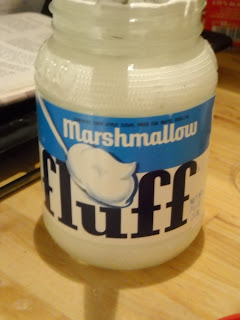 As a native Californian, I grew up spoiled by produce. As I've pointed out before, we had all the dried apricots we wanted. My father's cousins were almond and walnut growers, and we had a large freezer full of nuts. And of course there were the U-Pick farms and our backyard fruit trees and artichoke bush. I had grown up and moved to St. Louis before I realized that people actually paid good money for all these things.
As a native Californian, I grew up spoiled by produce. As I've pointed out before, we had all the dried apricots we wanted. My father's cousins were almond and walnut growers, and we had a large freezer full of nuts. And of course there were the U-Pick farms and our backyard fruit trees and artichoke bush. I had grown up and moved to St. Louis before I realized that people actually paid good money for all these things. So these California fruit bars give me a twinge of nostalgia for the days of a freezer full of goodies. Or Hadley's Orchards. Or even Trader Joe's. But still, look at the mixture of dried fruit I got from my favorite market vendor, the one who sells dried fruits and nuts and olives and beans and grains and spices. The one who flirts shamelessly with every woman who buys from him. The products he sells are really good, too. This "macedoine" had two kinds of apricots--sulfured and nonsulfured--, dried peaches, dried pineapple, and dried apples. I added some prunes because I love French prunes.
So these California fruit bars give me a twinge of nostalgia for the days of a freezer full of goodies. Or Hadley's Orchards. Or even Trader Joe's. But still, look at the mixture of dried fruit I got from my favorite market vendor, the one who sells dried fruits and nuts and olives and beans and grains and spices. The one who flirts shamelessly with every woman who buys from him. The products he sells are really good, too. This "macedoine" had two kinds of apricots--sulfured and nonsulfured--, dried peaches, dried pineapple, and dried apples. I added some prunes because I love French prunes. This is kind of a strange recipe. There's no butter, but lots of brown sugar (a whole pound--though I cut that down by a few ounces). You cook the eggs and sugar into a kind of custard before adding the flour and then the fruit and nuts.
This is kind of a strange recipe. There's no butter, but lots of brown sugar (a whole pound--though I cut that down by a few ounces). You cook the eggs and sugar into a kind of custard before adding the flour and then the fruit and nuts. What you end up with is a rather nasty-looking mixture--the photos I took of the bars ready to bake were not at all appetizing, let me just say.
What you end up with is a rather nasty-looking mixture--the photos I took of the bars ready to bake were not at all appetizing, let me just say. But what you get is a chewy, fruity, crunchy bar--sweet and tart with a nice caramel flavor from the brown sugar. It's California in so many ways--first of all, the fruit and nuts, but also that crunchy granola vibe. And like crunchy granola, these bars seem really healthy but are probably packed with calories. They'd make a great trail snack or breakfast, I think.
But what you get is a chewy, fruity, crunchy bar--sweet and tart with a nice caramel flavor from the brown sugar. It's California in so many ways--first of all, the fruit and nuts, but also that crunchy granola vibe. And like crunchy granola, these bars seem really healthy but are probably packed with calories. They'd make a great trail snack or breakfast, I think. Here's the recipe. Make it when you have some really nice dried fruit (from California or elsewhere) and want to give it the spotlight.
California Fruit Bars
1-2 c. (8-12 oz.) mixed dried fruit (Use your favorites; dates may be too sweet for this.)
4 large eggs
scant 2-1/2 c. (14 oz) brown sugar
1/4 t. salt
1 t. vanilla
2 c. (8 oz.) sifted flour (I used part whole wheat)
2 c. (7 oz.) walnut halves or large pieces
Use scissors to cut the fruit into small pieces or larger chunks--Maida says either way is fine. Place in a steamer basket over simmering water and let steam about 15 minutes--the fruit should become very soft.
Heat the oven to 400. Line a jelly-roll pan (10.5 by 15.5 inches) with foil or parchment; grease or butter the foil.
In a medium, heavy-bottomed saucepan, whisk together the eggs, sugar, and salt well. Cook the mixture over medium-low heat, stirring and scraping with a rubber spatula, until the sugar is completely melted--feel or taste to be sure. Take off the heat and add the vanilla. Then stir in the flour, one cup at a time, whisking well after each addition. Add the fruit and then the nuts, stirring carefully to make sure it doesn't clump up. Spread the mixture into the prepared jelly roll pan.
Bake for 15-16 minutes or until the cake is golden and shiny. Let cool in the pan before unmolding. Peel off the paper and use a long, thin knife to cut into bars of the size you'd like--since these are rather dense, smaller is probably better. Wrap individually or store in a sealed container. Enjoy the sunshine.






























